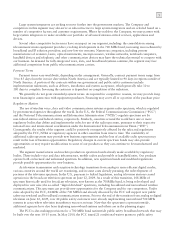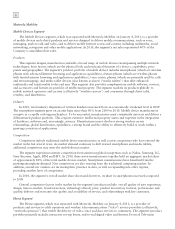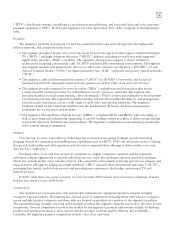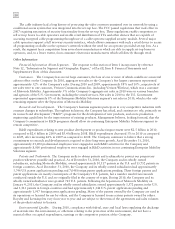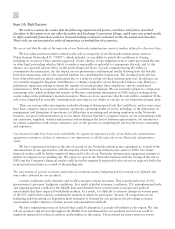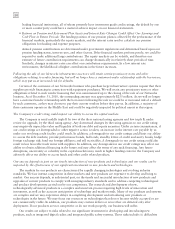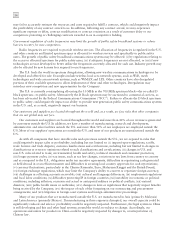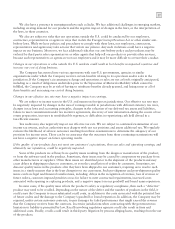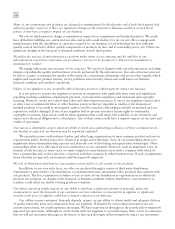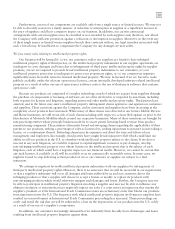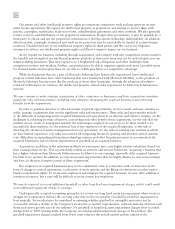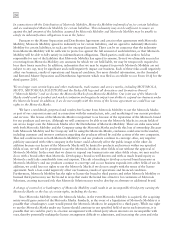Motorola 2010 Annual Report Download - page 23
Download and view the complete annual report
Please find page 23 of the 2010 Motorola annual report below. You can navigate through the pages in the report by either clicking on the pages listed below, or by using the keyword search tool below to find specific information within the annual report.
15
and delays in the development, production, testing and marketing of products; (ii) customer acceptance of products;
(iii) the development of, approval of, and compliance with industry standards; (iv) the significant amount of
resources we must devote to the development of new technologies; and (v) the ability to differentiate our products
and compete with other companies in the same markets.
We are exposed to risks under large multi-year system contracts that may negatively impact our business.
We enter into large multi-year system contracts with large municipal, state and nation-wide government
customers. This exposes us to risks, including: (i) the technological risks of such contracts, especially when the
contracts involve new technology, and (ii) financial risks under these contracts, including the estimates inherent in
projecting costs associated with large contracts and the related impact on operating results. We are also facing
increasing competition from traditional system integrators and the defense industry as system contracts become
larger and more complicated. Political developments also can impact the nature and timing of these large contracts.
In addition, multi-year awards from governmental customers may often only receive partial funding initially. The
termination of funding for a government program would result in a loss of anticipated future revenue attributable to
that program, which could have an adverse impact on our profitability.
In addition, we are increasingly being asked by our government customers to provide managed services, which
require that we partner with other systems providers, often through the formation of a multi-year joint venture, to
design, construct, manage and operate a public-safety system. Such public-private partnerships may require us to
assume the risk and agree to specific performance metrics that meet the customer’s requirement for network
availability, reliability, maintenance and support. In certain cases if these performance metrics are not met we may
not be paid. Depending on the nature of such projects, which are referred to as build-own-operate (“BOO”) and in
some cases maintain (“BOOM”) or transfer (“BOOT”), we may be unable to recognize revenue from the sale of
equipment for a period of time, which may be several years. Such BOO, BOOM and BOOT arrangements shift risk
to us and may result in an adverse impact on our profitability if we are unable to meet the requirements of such
contracts.
A portion of our business is dependent upon U.S. Government contracts and grants, which are highly regulated and
subject to oversight audits by U.S. Government representatives and subject to cancellations. Such audits could result
in adverse findings and negatively impact our business.
Our government business is subject to specific procurement regulations with numerous compliance
requirements. These requirements, although customary in U.S. Government contracting, increase our performance
and compliance costs. These costs may increase in the future, thereby reducing our margins, which could have an
adverse effect our on our financial condition. Failure to comply with these regulations could lead to suspension or
debarment from U.S. Government contracting or subcontracting for a period of time, and the inability to receive
future grants. Among the causes for debarment are violations of various laws, including those related to
procurement integrity, export control, U.S. Government security regulations, employment practices, protection of
the environment, accuracy of records, proper recording of costs, and foreign corruption.
Generally, U.S. Government contracts and grants are subject to oversight audits by U.S. Government
representatives. Such audits could result in adjustments to our contracts or grants. Any costs found to be improperly
allocated to a specific contract or grant may not be allowed, and such costs already reimbursed may have to be
refunded. Future audits and adjustments, if required, may materially reduce our revenues or profits upon
completion and final negotiation of audits. Negative audit findings could also result in investigations, termination of
a contract or grant, forfeiture of profits or reimbursements, suspension of payments, fines and suspension or
prohibition from doing business with the U.S. Government. All contracts with the U.S. Government are subject to
cancellation at the convenience of the U.S. Government.
We derive a portion of our revenue from government customers who award business through competitive bidding
which can involve significant upfront costs and risks. This effort may not result in awards of business or we may fail
to accurately estimate the costs to fulfill contracts awarded to us, which could have adverse consequences on our
future profitability.
Some government customers award business through a competitive bidding process, which results in greater
competition and increased pricing pressure. The competitive bidding process involves significant cost and
managerial time to prepare bids for contracts that may not be awarded to us. Even if we are awarded contracts, we


